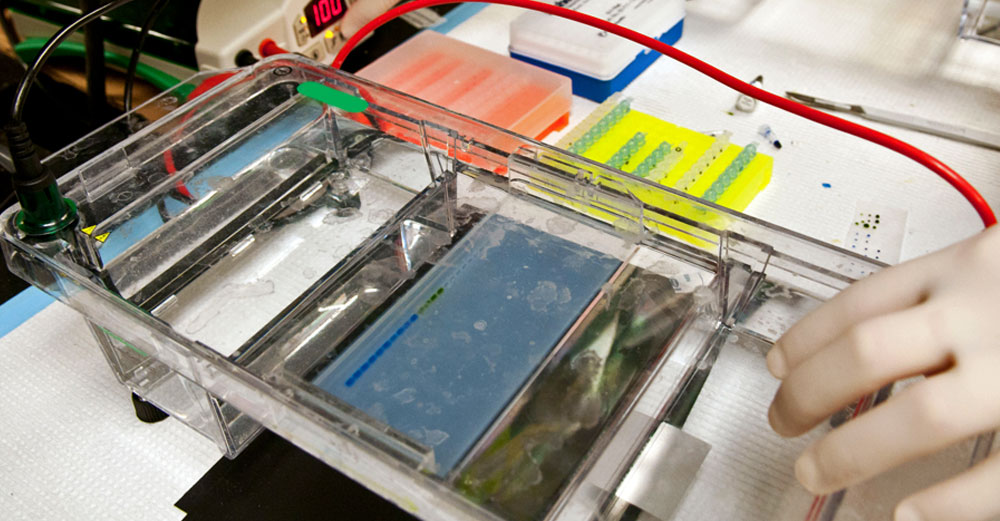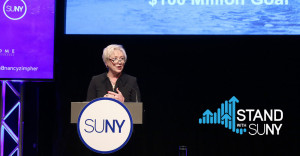
Rabi Musah, from the University at Albany, remembers with a combination of nostalgia and nightmare those post-doc days babysitting gel electrophoresis experiments.
Researchers who conduct lots of these experiments know that the constant monitoring can be a significant time sink.
If you’re not there at the end of the run, your precious sample oozes out of the far side of the gel, lost, along with your time – 45 minutes to several hours of analysis time, depending on the sample. If you are present at the end of the experiment and you shut off the power supply, you often have little time – maybe 60 minutes, maybe 20 minutes – to process or extract your sample before it diffuses into the gel medium.
“You have to plan your day around that equipment, particularly if you are working with new samples, since you don’t always know how long it will take for the experiment to end,” says Musah, a bioorganic chemist and associate professor. “You step out to grab a sandwich and, if you’re not careful, your sample is gone.”
So when she enrolled a few years ago in an inter-departmental class that paired MBA candidates with researchers to develop products that could be brought to market, it wasn’t tough to develop an idea.
She asked Papa Nii Asare-Okai, a postdoctoral research colleague who now works at the University of Delaware: What do you hate most having to do during day to day operations in the lab?
Answer: Gel electrophoresis.
Me, too.
Idea born.
An Idea is Brought to Life
The novel apparatus they devised to address the problem won a $50,000 prize through The RNA Institute‘s Student Venture Fund. That financial support enabled research and development. Now, the technology has won another $50,000 investment by SUNY’s Technology Accelerator Fund.
To appreciate the merits of the device, it helps to understand how gel electrophoresis works. The process separates macromolecules – DNA, RNA, proteins and the like – that are embedded within a gel by running an electric current through the medium. This causes the molecules in the mixture to travel from one end of the gel to the other.
The molecules migrate through the gel at different rates. The smaller molecules move faster, and the larger ones lag behind. Since it is impossible to watch the molecules as they move, researchers use a dye to visually follow the progress of the experiment. Generally, the migration of the dye across the length of the gel marks the end of the experiment, and this is what needs to be monitored.
Two issues had to be addressed to automate the system effectively:
First, stopping the flow of current when the experiment is complete – this was not too difficult; an optical sensor trips when it detects dye at a designated position on the gel.
Second, and a bit trickier, was retaining each of the separated components in their respective positions so that they didn’t diffuse throughout the gel matrix, resulting in sample loss.
Done, in a method that Musah describes only as “proprietary.” A working prototype sits on her work bench. It’ll even email, text or telephone the analyst when the sample is ready.
The cost savings in terms of time is immense, particularly where large numbers of experiments are conducted for long periods. It also prevents loss of valuable – in some cases, priceless – samples. This device allows the analyst to get it right the first time.
The TAF award will fund the next step, which is to bring the system to market. Over the next year or so, Musah will refine the system, and design and build a housing for the contraption of wires and sensors on her bench. She’ll also make sure the system interfaces with the range of gel electrophoresis equipment on the market.
Musah expects the system will add about $50 to the price of a typical gel electrophoresis apparatus. That’s not much compared to the $1,500 price tag of each of the electrophoresis stations in her lab, and very little as a share of the larger, automated machines that bio-pharma companies use.
Musah isn’t sure what direction to take. She could create a company to market a stand-alone device that could interface with any gel electrophoresis setup. Or, she could license the technology to a company that would incorporate it into its exclusive systems. “They could completely corner the market,” Musah says.
The device also allows the student researcher, post-doc, or other lab tech, to multi-task worry free. “Babysitting gel electrophoresis experiments is mindless tedium,” Musah says. “You’re paying someone to use their brainpower to babysit a gel. What a waste!”
And maybe that post-doc will have time to grab a sandwich.



